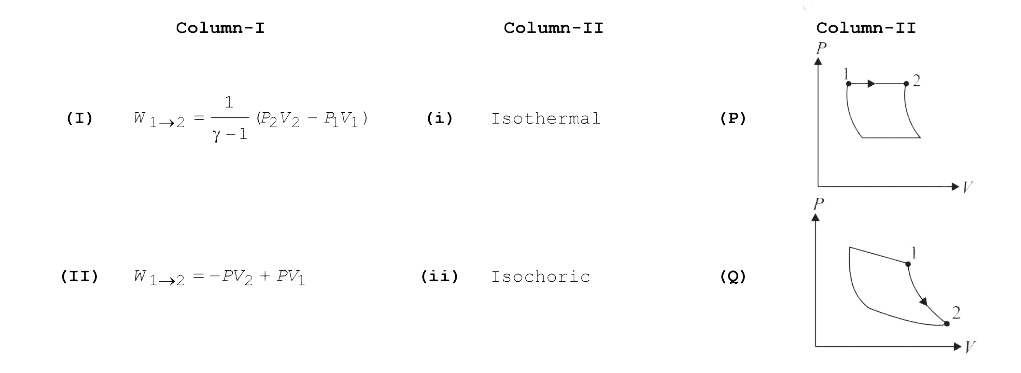An ideal gas is undergoing a cyclic thermodynamic process in different ways as shown in the corresponding P-V diagrams in column 3 of the table. Consider only the path from state 1 to state 2. W denotes the corresponding work done on the system. The equations and plots in the table have standard notations as used in thermodynamic process. Here is the ratio of heat capacities at constant pressure and constant volume. The number of moles in the gas in n.


Which of the following options is the only correct representation of a process in which ΔU=ΔQ−PΔV?
(I) (iv)(Q)
(III) (iv) (R)
(I) (ii) (Q)
(IV) (ii) (R)
The correct Answer is:A
Laplace correction is done is correction in the determination of the speed of sound in an ideal gas, which states that the process assumed was not Isothermal but it is Adiabatic
Wadiabatril→2=1γ−1(P2V2−P1V1)
Corresponding graph is

Similar Questions
In the graph shown below A-B, B-C , C-D are parts of the carnot cycle operating on an ideal gas.Consider only the path from State 1 to State 2 . W denotes the work in the path. Equations and plots in the table have standard notations γ is the ratio of heat capacities at constant pressure and constant volume. The moles of the gas is 'n'.

For which of the following options dQrev(sys)T>0 and simultaneously dQirrev(sys)T>0 If taken irreversibly
View SolutionAn ideal gas system undergoes an isothermal process, then the work done during the process is
View Solution
Knowledge Check
An ideal gas is undergoing a cyclic thermodynamic process in different ways as shown in the corresponding P-V diagrams in column 3 of the table. Consider only the path from state 1 to state 2. W denotes the corresponding work done on the system. The equations and plots in the table have standard notations as used in thermodynamic process. Here is the ratio of heat capacities at constant pressure and constant volume. The number of moles in the gas in n.


Which of the following options is the only correct representation of a process in which ΔU=ΔQ−PΔV?A(IV) (ii) (S)B(III) (ii) (S)C(II) (iv) (R)D(II) (iv) (P)In the graph shown below A-B, B-C , C-D are parts of the carnot cycle operating on an ideal gas.Consider only the path from State 1 to State 2 . W denotes the work in the path. Equations and plots in the table have standard notations γ is the ratio of heat capacities at constant pressure and constant volume. The moles of the gas is 'n'.

For which of the following options dQirrev(sys)T>dQrev(sys)TA(I)(iv)(Q)B(IV)(i)(P)C(II)(iii)(R)DNone of theseIn the graph shown below A-B, B-C , C-D are parts of the carnot cycle operating on an ideal gas.Consider only the path from State 1 to State 2 . W denotes the work in the path. Equations and plots in the table have standard notations γ is the ratio of heat capacities at constant pressure and constant volume. The moles of the gas is 'n'.

For which of the following options dQrevsysT=0 and dQrev(sys)T=0 it taken irreversiblyA(I)(iv)(Q)B(IV)(i)(P)C(II)(iii)(R)DNone of these
An ideal gas system undergoes an isothermal process, then the work done during the process is
View SolutionAn ideal gas undergoes a cyclic process whose indicator diagram is as shown in the figure. Find the work done by the gas in 1 complete cycle.

View SolutionPV Diagram for ideal gas in piston cylinder assembly undergoing a thermodynamic process is shown in figure. Process is

View SolutionIf a monoatomic gas undergoes a thermodynamic proces for which its molar heat capacity is equal to the universal gas constant. What is the process in terms of V and T ?
View SolutionIn changing the state of thermodynamics from A to B state, the heat required is Q and the work done by the system is W. The change in its internal energy is
View Solution
